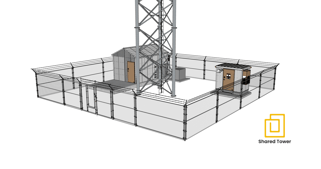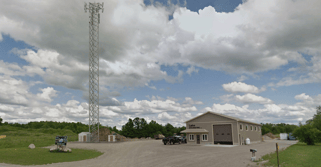A Vision for Rural Connectivity: Shared Towers and the Shared Edge
Over the past few years, “Edge” technologies and applications have become more and more prevalent. In most cases, it can be assumed that this type of technology is being integrated in high traffic, urban settings. Rural communities that lack access to broadband are at a significant disadvantage. Carriers large and small, as well as various layers of government, have focused on eliminating this disadvantage. Bridging this divide requires end-to-end examination of current and planned communications networks, with a focus on adapting them to solving this important challenge.

Many are familiar with edge technologies and applications in the urban environment, but did you know this approach can be a critical enabler in a rural environment? Over the past few years, edge technologies and applications are more prevalent. In most cases, it is assumed that this type of technology is focused on pushing cloud computing nodes deeper into high traffic, urban settings. Where does this leave rural communities and their continued struggle for even the most basic access to connectivity?
The Rural Edge

The discussion about remote connectivity is rightfully front and center – but last mile access is often the sole focus. For instance, upgrades of DSL or wireless access to fiber get significant airtime. However, even with superior last-mile networks, remote communities still lack equally critical upstream connectivity to get their customer traffic out to the internet. Canada has relatively few carrier hotels and internet exchange operators, and those locations are in major urban centers prohibitively far away from rural communities. In the race to upgrade last-mile rural networks, Governments and carriers have struggled to keep upstream capacity aligned with the ambitions of the stakeholders supporting these projects.
A compounding issue is that carrier hotel and IX facilities are typically cost-prohibitive for smaller rural network operators, who without a presence at the nearest carrier hotel, are excluded from an internet exchange located there. These ISPs rely on Incumbent Local Exchange Carriers (ILECs) IP transit service and subordinate their networks to get traffic out to the internet even if there is network transport available in their market.
Expanding in Rural Areas

Rural operators can gain access to the global IX market without the need for colocation by leveraging software defined network services at tower and edge locations. Shared Tower's IX-in-a-Box carrier exchange concept and expansive portfolio creates the same collaborative spirit and the aggregation of demand that is created in carrier hotels by traditional IX operators.
Neutral shared edge hubs use high capacity fiber to connect local networks with long-haul transport to bring large scale fiber connectivity to remote communities. This innovation allows network providers to get better upstream at a more compelling cost, and offer performance to their customer base.
The opportunity for rural Canada is significant: lower latency, lower costs and more secure connectivity. This approach can help bridge the digital divide.
The Shared Tower and Morrison Hershfield Collaboration
Shared Tower’s vision, partnered with Morrison Hershfield’s engineering expertise, has laid the groundwork for the development of more reliable fiber communications infrastructure encompassing real estate acquisition, towers, neutral fiber, and shared edge colocation facilities. Shared Tower and its predecessor entities have developed more than 1,500 mobile sites across Canada. Morrison Hershfield’s expertise includes the engineering and management of telecommunications networks including edge, FTTx, cell sites, hubs, carrier hotels and data centers. The collaboration has earned the trust of Canada’s major carriers by delivering network infrastructure faster and more efficiently than traditional means, and provide the much-needed reliability and network speed that rural communities depend on for their communication and future technology needs.
Posts by Topic
Topics
- 5G (1)
- ACEC (3)
- Active Transportation (5)
- AFP/P3 (6)
- Alberta (5)
- Anniversary (1)
- approvals (1)
- Architect (2)
- Atlanta (2)
- Awards (62)
- Biophysical Sciences (1)
- Board of Directors (1)
- Bridge Rehabilitation (3)
- Building and Facilities Engineering (2)
- Building Energy (25)
- Building Envelope (48)
- Building Science (65)
- Calgary (2)
- Canada 150 (1)
- Canstruction (2)
- Capabilities (1)
- Carbon emissions (2)
- Carbon Pathfinder Tool (1)
- Carson Awards (5)
- Charity (13)
- Climate Adaption (7)
- climate change (7)
- Code and Life Safety (8)
- Commercial Buildings (4)
- Commissioning (11)
- Construction (2)
- Construction Administration (5)
- Consulting Engineering (1)
- Critical Facilities (33)
- CSR (24)
- Culture (5)
- Dallas (1)
- Data Center (22)
- Data Center Commissioning (9)
- Data Center Design (12)
- design (9)
- Design Build (1)
- DSSP (1)
- edgecomputing (1)
- edgetechnologies (1)
- Edmonton (4)
- Electrical (24)
- Electrical engineering (8)
- Energy (8)
- Engineers Canada (5)
- Environmental (36)
- Environmental Compensation (1)
- Environmental Impact Assessment (3)
- environmental planner (3)
- Environmental Planning (5)
- ETFE (1)
- Event (12)
- Existing Buildings (6)
- Facade Engineering (4)
- Ferry Docks (2)
- FIDIC (3)
- fisheries biologist (1)
- Flood Mapping (1)
- Florida (1)
- Forensic Investigation (1)
- Fundraising (11)
- garage (2)
- Gender Diversity (8)
- Gender Intelligence (3)
- Geometric Design (2)
- Government (14)
- Hospitality (1)
- Houston (4)
- Hydro (2)
- India (1)
- industrial (4)
- Infrastructure (28)
- Innovation (1)
- interchange (1)
- IWD (2)
- IWD2021 (1)
- Land Development (8)
- Landfill (4)
- Manitoba (1)
- MCF (3)
- Mechanical (21)
- Mechanical Engineering (1)
- MEP (1)
- mission critical (10)
- Moncton (1)
- Motivational MH'er (1)
- Multi-Use Pathways (1)
- Municipal Infrastructure (5)
- municipal solid waste (2)
- MUP (1)
- New Brunswick (1)
- New Hire (17)
- New Role (3)
- Newsroom (121)
- northern communities (2)
- NVTC (2)
- ontario (1)
- Operations Consulting (8)
- Ottawa (2)
- Panel (3)
- People (124)
- Project Management (6)
- QAP (1)
- Rail (1)
- Reconstruction (1)
- regulatory (1)
- Renewable Energy (2)
- resiliency (3)
- Risk Management (1)
- Roads and Highways (3)
- Salt Lake City (1)
- Seattle (1)
- Security (4)
- Social Responsibility (30)
- Solid Waste (11)
- solid waste management (5)
- St Johns (2)
- Stantec (1)
- Structural (14)
- Sustainability (23)
- Telecom (9)
- Texas (1)
- Toronto (13)
- towers (1)
- Traffic Assessment (2)
- Transfer Station (1)
- Transit (13)
- Transit Consultant (3)
- Transit Infrastructure (3)
- Transit Planning (2)
- Transportation (30)
- Transportation Engineering (8)
- transportation structures (2)
- TTC (1)
- Vancouver (6)
- Virginia (2)
- Washington DC (3)
- Waste to Energy (2)
- Water & Wastewater (8)
- Water Resources (3)
- wellfield (1)
- wellness challenge (1)
- Whistler (1)
- Whitehorse (1)
- Wireless (2)
- Women in Engineering (5)
- Yukon (5)